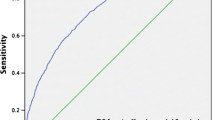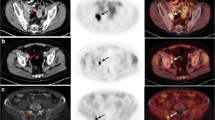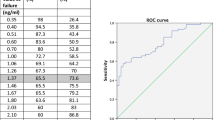Abstract
Purpose
The aim of this study was to evaluate the potential usefulness of whole-body 11C-choline PET/CT in the re-staging of prostate cancer (PC) patients previously treated with radical prostatectomy (RP), who presented a mild increase of prostate-specific antigen (PSA) <1.5 ng/ml (early biochemical relapse) during follow-up (FU).
Methods
We evaluated 102 consecutive patients (mean age = 68 years, range = 54–82 years) previously treated with RP and who presented during FU a mild increase of trigger PSA serum levels <1.5 ng/ml: mean 0.86 ± 0.40 ng/ml (range 0.2–1.5) and median 0.93 ng/ml (range 0.67–1.10). In this patient series 11C-choline PET/CT was used as the first imaging examination at the time of the detection of a mild serum PSA increase <1.5 ng/ml. 11C-Choline PET/CT was performed following standard procedures in our centre. At the time of PET/CT, 86 patients were not receiving any pharmacologic treatment, while 16 were under anti-androgenic therapy. Positive PET findings were validated by: (a) transrectal ultrasound (TRUS)-guided biopsy in cases of local recurrence, (b) surgical lymphadenectomy, (c) other imaging procedures or (d) FU lasting for at least 12 months. Univariate and multivariate analyses were used to evaluate the following variables: age, TNM staging, Gleason score, time from RP to the biochemical relapse, anti-androgen therapy at the time of 11C-choline PET/CT scan, trigger PSA value and PSA kinetics, i.e. PSA doubling time (PSAdt) and PSA velocity (PSAvel), in order to assess the significant predictive factors related to the findings of a positive 11C-choline PET/CT scan.
Results
Overall, 11C-choline PET/CT showed positive findings in 29 of 102 patients (28% of cases). In detail, 11C-choline PET/CT detected: local relapse in 7 patients, bone metastases in 13 patients (4 single and 9 multiple) and lymph node metastases in 9 patients (6 single and 3 multiple). Positive PET findings were validated by: (a) TRUS-guided biopsy in 7 patients with local recurrence, (b) surgery and lymphadenectomy in 3 patients, (c) other targeted imaging procedures (MR or bone scan) in 5 patients and (d) clinical FU lasting a minimum of 12 months and including also a contrast-enhanced CT (CECT), an MR, a bone scan and a repeated 11C-choline PET/CT in 14 patients. Age, time to biochemical relapse (TTR), initial T staging, Gleason score and trigger PSA were not statistically significant in predicting a positive 11C-choline PET/CT scan both at univariate and multivariate analysis. Instead, PSA kinetics (PSAdt and PSAvel), N status and anti-androgenic therapy at the time of PET scan were statistically significant predictive factors at univariate analysis. Of note, only PSAdt and initial N status were found to be significant and independent predictive factors at multivariate analysis. The mean PSAdt in PET-positive patients was 4.34 months (SD 2.82) while in PET-negative patients it was 13.30 months (SD 9.75) (p = 0.0001). The optimal threshold for PSAdt established by receiver-operating characteristic (ROC) analysis was 7.25 months (AUC 0.85; 95% confidence interval 0.77–0.91) providing 93% sensitivity, 74% specificity, 60% positive predictive value and 96% negative predictive value.
Conclusion
In our study, 11C-choline PET/CT was able to detect recurrent disease in 28% of the patients with mild biochemical relapse characterized by very low trigger PSA levels (PSA <1.5 ng/ml). Very interestingly 11C-choline PET/CT detected distant unexpected metastases in 21% of the patients. At multivariate statistical analysis only PSAdt and node status were shown to be significant and independent predictive factors for positive 11C-choline PET/CT. Therefore, 11C-choline could be suggested to be performed early during initial biochemical relapse in patients presenting with fast PSA kinetics. The early detection of the site of recurrence could lead to a prompt instauration of the most appropriate treatment, i.e. local surgery or radiation treatment vs systemic treatment. In this view, one of the main advantages should be the avoidance of unnecessary local radiotherapy in those patients showing distant metastasis at 11C-choline PET/CT.




Similar content being viewed by others
References
Kataja VV, Bergh J. ESMO Minimum Clinical Recommendations for diagnosis, treatment and follow-up of prostate cancer. Ann Oncol 2005;16 Suppl 1:i34–6.
Freedland SJ, Presti JC Jr, Amling CL, Kane CJ, Aronson WJ, Dorey F, et al. Time trends in biochemical recurrence after radical prostatectomy: results of the SEARCH database. Urology 2003;61:736–41.
Han M, Partin AW, Zahurak M, Piantadosi S, Epstein JI, Walsh PC. Biochemical (prostate specific antigen) recurrence probability following radical prostatectomy for clinically localized prostate cancer. J Urol 2003;169:517–23.
Chism DB, Hanlon AL, Horwitz EM, Feigenberg SJ, Pollack A. A comparison of the single and double factor high-risk models for risk assignment of prostate cancer treated with 3D conformal radiotherapy. Int J Radiat Oncol Biol Phys 2004;59(20):380–5.
Roberts SG, Blute ML, Bergstralh EJ, Slezak JM, Zincke H. PSA doubling time as a predictor of clinical progression after biochemical failure following radical prostatectomy for prostate cancer. Mayo Clin Proc 2001;76:576–81.
Choueiri TK, Dreicer R, Paciorek A, Carroll PR, Konety B. A model that predicts the probability of positive imaging in prostate cancer cases with biochemical failure after initial definitive local therapy. J Urol 2008;179(3):906–10.
Beresford MJ, Gillatt D, Benson RI, Ajithkumar T. A systematic review of the role of imaging before salvage radiotherapy for post-prostatectomy biochemical recurrence. Clin Oncol (R Coll Radiol) 2010;22:46–55.
Boccon-Gibod L, Djavan WB, Hammerer P, Hoeltl W, Kattan MW, Prayer-Galetti T, et al. Management of prostate-specific antigen relapse in prostate cancer: a European Consensus. Int J Clin Pract 2004;58(4):382–90.
Hara T, Kosaka N, Kishi H. PET imaging of prostate cancer using carbon-11-choline. J Nucl Med 1998;39:990–5.
Cimitan M, Bortolus R, Morassut S, Canzonieri V, Garbeglio A, Baresic T, et al. [18F]fluorocholine PET/CT imaging for the detection of recurrent prostate cancer at PSA relapse: experience in 100 consecutive patients. Eur J Nucl Med Mol Imaging 2006;33:1387–98.
Krause BJ, Souvatzoglou M, Tuncel M, Herrmann K, Buck AK, Praus C, et al. The detection rate of [11C]choline-PET/TC depends on the serum PSA-value in patients with biochemical recurrence of prostate cancer. Eur J Nucl Med Mol Imaging 2008;35:18–23.
Picchio M, Messa C, Landoni C, Gianolli L, Sironi S, Brioschi M, et al. Value of [11C]choline-positron emission tomography for re-staging prostate cancer: a comparison with [18F]fluorodeoxyglucose-positron emission tomography. J Urol 2003;169:1337–40.
Pascali C, Bogni A, Itawa R, Cambiè M, Bombardieri E. [11C]Methylation on a C18 Sep-Pak cartridge: a convenient way to produce [N-methyl-11C]choline. J Labelled Comp Radiopharm 2000;49:195–203.
Khan MA, Carter HB, Epstein JI, Miller MC, Landis P, Walsh PW, et al. Can prostate specific antigen derivatives and pathological parameters predict significant change in expectant management criteria for prostate cancer? J Urol 2003;170:2274–8.
Svatek RS, Shulman M, Choudhary PK, Benaim E. Critical analysis of prostate-specific antigen doubling time calculation methodology. Cancer 2006;106:1047–53.
Zeisel SH. Dietary choline: biochemistry, physiology, and pharmacology. Annu Rev Nutr 1981;1:95–121.
Ackerstaff E, Pflug BR, Nelson JB, Bhujwalla ZM. Detection of increased choline compounds with proton nuclear magnetic resonance spectroscopy subsequent to malignant transformation of human prostatic epithelial cells. Cancer Res 2001;61:3599–603.
Sutinen E, Nurmi M, Roivainen A, Varpula M, Tolvanen T, Lehikoinen P, et al. Kinetics of [(11)C]choline uptake in prostate cancer: a PET study. Eur J Nucl Med Mol Imaging 2003;31:317–24.
Glunde K, Shah T, Winnard PT, Raman V, Takagi T, Vesuna F, et al. Hypoxia regulates choline kinase expression through hypoxia-inducible factor-1 alpha signaling in a human prostate cancer model. Cancer Res 2008;68:172–80.
Cher ML, Bianco FJ, Lam JS, Davis LP, Grignon DJ, Sakr WA, et al. Limited role of radionuclide bone scintigraphy in patients with prostate specific antigen elevations after radical prostatectomy. J Urol 1998;160:1387–91.
Gomez P, Manoharan M, Kim SS, Soloway MS. Radionuclide bone scintigraphy in patients with biochemical recurrence after radical prostatectomy: when is it indicated? BJU Int 2004;94:299–302.
Leventis AK, Shariat SF, Slawin KM. Local recurrence after radical prostatectomy: correlation of US features with prostatic fossa biopsy findings. Radiology 2001;219:432–9.
Scattoni V, Roscigno M, Raber M, Montorsi F, Da Pozzo L, Guazzoni G, et al. Multiple vesico-urethral biopsies following radical prostatectomy: the predictive roles of TRUS, DRE, PSA and the pathological stage. Eur Urol 2003;44:407–14.
Giovacchini G, Picchio M, Coradeschi E, Bettinardi V, Gianolli L, Scattoni V, et al. Predictive factors of [(11)C]choline PET/CT in patients with biochemical failure after radical prostatectomy. Eur J Nucl Med Mol Imaging 2010;37:301–9.
Husarik DB, Miralbell R, Dubs M, John H, Giger OT, Gelet A, et al. Evaluation of [(18)F]-choline PET/CT for staging and restaging of prostate cancer. Eur J Nucl Med Mol Imaging 2008;35:253–63.
Castellucci P, Fuccio C, Nanni C, Santi I, Rizzello A, Lodi F, et al. Influence of trigger PSA and PSA kinetics on 11C-choline PET/CT detection rate in patients with biochemical relapse after radical prostatectomy. J Nucl Med 2009;50:1394–400.
Giovacchini G, Picchio M, Scattoni V, Garcia Parra R, Briganti A, Gianolli L, et al. PSA doubling time for prediction of [(11)C]choline PET/CT findings in prostate cancer patients with biochemical failure after radical prostatectomy. Eur J Nucl Med Mol Imaging 2010;37:1106–16.
Acknowledgments
The authors would like to thank Dr. Azahara Palomar from the Department of Nuclear Medicine at the Hospital Universitario Ciudad Real, Spain, for her contribution to the release of this work and Dr. Cristina Fonti for her contribution to the statistical analysis.
Conflicts of interest
None.
Author information
Authors and Affiliations
Corresponding authors
Rights and permissions
About this article
Cite this article
Castellucci, P., Fuccio, C., Rubello, D. et al. Is there a role for 11C-choline PET/CT in the early detection of metastatic disease in surgically treated prostate cancer patients with a mild PSA increase <1.5 ng/ml?. Eur J Nucl Med Mol Imaging 38, 55–63 (2011). https://doi.org/10.1007/s00259-010-1604-0
Received:
Accepted:
Published:
Issue Date:
DOI: https://doi.org/10.1007/s00259-010-1604-0




